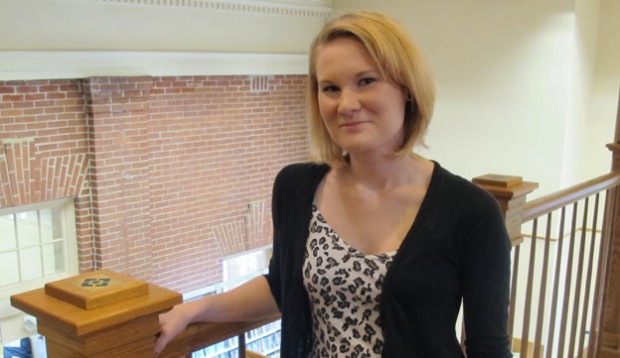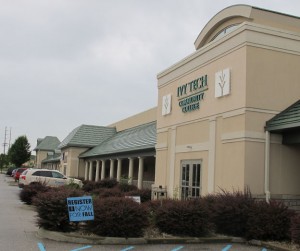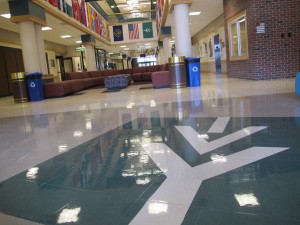How A Statewide Space Shortage Is Affecting Ivy Tech Students

Kyle Stokes / StateImpact Indiana
Sonya Claiborne, 24, is on track to graduate from Ivy Tech Community College's Lafayette campus this fall. Though the school's space shortage affected her experience, Claiborne says her time at the school was overwhelmingly positive.
Sonya Claiborne enrolled at Ivy Tech Community College for one of the same reasons more than a million people nationwide flocked to two-year schools during the recession: She wanted a better job.
She worked a string of low-wage jobs for four years after high school. Then she signed up for classes on the Lafayette campus, hoping to eventually apply to Ivy Tech’s surgical technology program.
Then Claiborne learned how few open slots the program had — and how critical Ivy Tech’s shortage of lab space was. She changed her focus to business administration instead.
- Space Case: Ivy Tech Students 'Elbow To Elbow' On CampusesStateImpact Indiana‘s Kyle Stokes Download
Ivy Tech’s enrollment statewide has grown more than 70 percent since 2007. But the school hasn’t built any new permanent classroom space since then, leaving the statewide system more than 800,000 square feet short of space.

Kyle Stokes / StateImpact Indiana
Because Ivy Tech has outgrown its permanent campus in Bloomington, the community college now offers classes in an off-campus shopping center. Their neighbors: a Mexican restaurant, office space for a defense contractor, and a private tutoring center.
—John Whikehart, Ivy Tech Bloomington chancellor
Claiborne, 24, doesn’t begrudge Ivy Tech for the competitive admissions process into its “surg. tech” program. She says her experience at the school has been largely positive — she’s on track to graduate with two associates degrees this December.
But Claiborne also says the space deficit has broad impacts on Ivy Tech students. She says there’s precious little space for students to sit, eat and study on the Lafayette campus. Computer labs are crowded too. And while Claiborne says she dropped her surgical technology plans for many reasons, she says the space shortage was a factor.
“In reality, that’s cutting down on the spots open for the program,” Claiborne says. “Less people are getting into the program, so that means there’s less people with degrees going out within our community to fill the need in our hospitals or nursing homes.”
Growing Fast While Economy Slowed
Ivy Tech president Tom Snyder says when the last state budget was drawn up in 2009, Indiana was still weathering the worst of the economic recession, and lawmakers weren’t eager to spend on building projects.
“I think you have to look at 2008, 2009 — the economic concerns of the state — which was, ‘Could Ivy Tech still get these people enrolled and educated in some way when things were very difficult?’” Snyder says. “We were able to do that job.”
But in the meantime, Ivy Tech’s student population kept growing. Since 2007, Ivy Tech’s enrollment has ballooned from just under 80,000 students to more than 120,000 today. Administrators say that means the school’s campuses in Muncie, Lafayette, South Bend, Fort Wayne and Columbus all have an immediate need for more space.
Immediate pricetag: Between $100 and $200 million in next year’s state budget.
The school has accommodated its burgeoning student population by renting classroom trailers and storefronts in shopping centers and strip malls. Currently, roughly one quarter of the school’s footprint is leased. But Snyder tells StateImpact that approach to solving space shortages is not sustainable:
Space has got to be a critical factor, but we were able to live within our space needs for the past four years. We are not going to be able to continue to do that. We have a lot of leased property. The leased property comes at the expense of hiring faculty. The faculty are needed to teach the students. In some of our cities, we’re in leased buildings that are 40 years old that are going to have to be renovated. Those issues are going to have to be addressed. Can’t be done without new money. Can’t be done without the support of the general assembly.
‘People In Higher Ed Love To Put Their Names On Buildings’
12 of the college system’s 14 regions statewide are short on space, according to a December 2011 presentation to the Indiana Commission for Higher Education. Ivy Tech’s master plan calls for an estimated $435 million in state funds over the next decade to build new facilities and renovate old buildings.
Ivy Tech Bloomington chancellor John Whikehart says state leaders praise the school’s role in expanding access to post-secondary education. Now, he says, it’s time for them to put up state dollars for new buildings.
“We all want [students] to earn education and training so they’re able to get jobs, but we’re not willing to pay for it,” Whikehart says. “And that’s the issue. Are we willing to pay for what we’re willing to accomplish?”

Kyle Stokes / StateImpact Indiana
Ivy Tech's Lafayette campus is one administrators are likely to include in the school's request for state money for building projects this year.
But facilities issues are nothing new for Indiana’s higher education institutions. Purdue University officials say they’ve deferred more than $428 million in building projects and maintenance. Indiana University administrators say the school has a $600 million maintenance backlog. The state has made cuts to funds institutions could previously count on to cover these “renovation and rehabilitation” costs.
While Governor Mitch Daniels says the state clearly must address Ivy Tech’s space issues, there are alternatives to building. Daniels says the school can continue to lease space as well as direct more students to taking courses online.
“Sometimes permanent space is the right answer — but not always,” Daniels says. “The system needs to keep some flexibility. Folks in higher ed love to build buildings — put people’s names on them and so forth.”
Students Keep Perspective
For some students, the school’s space issues are all relative.
Recent Ivy Tech graduate Caleb Hoagland enrolled just after leaving the military. Even with the school at capacity, he says the community college atmosphere is more intimate than at a larger university.
“Yeah, there’s some overcrowding,” Hoagland says. “But still — overcrowding and there’s 30 people in the room versus overcrowding and there’s 300 people in a lecture hall.”
Both Hoagland and Sonya Claiborne says they’re taking their experience at Ivy Tech with them to the state’s four-year colleges.
Hoagland recently took courses at Indiana State University, and will enroll at Ball State University in the fall with hopes of attaining a political science degree.
After graduating from Ivy Tech in December, Claiborne says she plans to attend Purdue.
Podcast: Play in new window | Download

